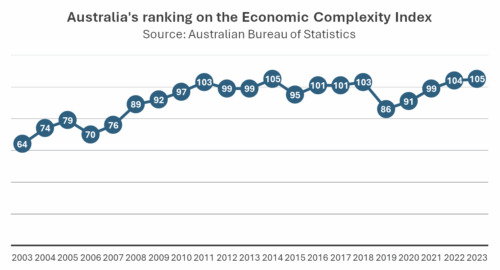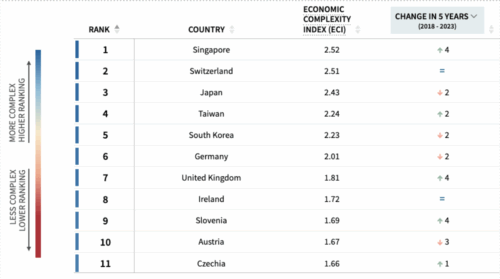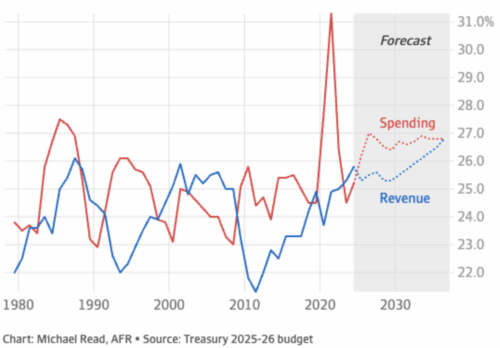

The economic future of Australia was central at the 2025 Economic Reform Roundtable, where experts discussed how to lift the country out of its current sluggish growth and guide it on a stronger path. Concern about our stagnant productivity dominated the three-day conversation, alongside equally pressing issues of resilience and fiscal management. From the discussion, three key opportunities emerged as potential solutions to current challenges: boosting productivity to drive prosperity, building greater economic resilience and strengthening budget management to secure the nation’s future.

Figure 1: The Parliament House of Australia – located in Canberra
Source: Parliament of Australia
At the 2025 Economic Reform Roundtable, economists and policymakers emphasised productivity as Australia’s most urgent economic challenge, describing it as the engine of wages, living standards and the nation’s fiscal strength. Yet, our performance has been concerningly bleak. Labour productivity has flatlined at just 0.4% per year, the weakest in sixty years, while GDP per capita growth has been similarly underwhelming, barely keeping pace with population growth. In some industries, output per worker has even gone backwards. These trends signal that Australia is in a prolonged slump, struggling to make effective use of both its people and its resources. The Productivity Commission warns that without stronger productivity growth, wages and living standards will eventually stall. And with productivity stuck, the government also collects less revenue. Hence, it is challenging to fund healthcare, education and aged care without raising taxes or debt. Boosting productivity, therefore, can soothe Australia’s economic distress without putting pressure on the average citizen.
The Economic Roundtable identified various key obstacles that are stifling growth. A recurring theme was that onerous regulations and lengthy approval processes hinder production and investment. Energy and infrastructure projects face years of delay due to overlapping state and federal approvals. Business leaders argued that excessive red tape at all levels of government is “eating into valuable time”, delaying investments and reducing economic dynamism. These regulatory hurdles feed directly into another challenge, weak business investment. The Productivity Commission flagged “low rates of business investment” as a key contributor to the productivity slowdown. The era of easy productivity gains from IT or mining booms has faded. However, new technologies, such as automation and AI, are not being widely adopted. Risk aversion, financing hurdles and low rates of start-up creation were all flagged as contributing to a low innovation environment, leaving Australia lagging its global peers and translating into scant productivity gains. There is also a vulnerability in where capital is flowing. If investment continues to be funnelled mainly into property, finance and mining, the potential of AI and other technologies will remain underutilised, and the labour freed up by automation will lack productive sectors to be absorbed into.
Human capital is also not being used efficiently. Although unemployment is low, many technical and trade roles remain difficult to fill, while simultaneously over 620,000 permanent migrants are working below their qualification level because of red tape, slow credentialing and licensing issues. This points to a “broken” system for recognising overseas qualifications and licensing foreign-trained professionals. Likewise, barriers between jurisdictions mean even Australians moving interstate can have trouble getting their credentials recognised. All of this represents a huge underutilisation of human capital that directly drags on productivity.
These inefficiencies are especially damaging given Australia’s demographic trajectory. Migrants are expected to help fill critical gaps created by an ageing workforce, yet if their skills remain locked out of key industries, the demographic pressure only worsens. As more workers move into services such as health and aged care, vital but labour-intensive industries where efficiency gains are limited, aggregate productivity growth slows. Australia’s ageing population will continue to intensify this trend, requiring other sectors to innovate rapidly to keep output steady. In addition to the above, some speakers lamented a period of policy complacency, noting a “lack of interest in pro-growth reforms” over many years.
Against this troubling backdrop, the table argued for a broad reform agenda. Priorities emphasised were streamlining approvals, fixing skills recognition through a national accreditation system and investing in training to prepare workers for a more digital economy. Proposals to lift investment ranged from tax incentives for R&D to cutting the corporate tax rate. Infrastructure improvements in energy and transport are enablers of cheaper, more reliable inputs that can raise efficiency across the economy. Speakers emphasised that productivity gains must benefit workers and communities through higher wages, better services and improved quality of life. Technology and innovation are tools to achieve this, with reforms needed to ensure adoption raises job quality and economic opportunity rather than leaving workers behind. The challenge that remains is turning these ambitions into action, so productivity reforms can deliver tangible improvements across Australia’s economy and society.
Overall, it is clear that reviving productivity is not optional. Stronger wages, better services and resilient growth all depend on it. Without it, Australia’s stagnation looms, and with it, the country can secure sustainable prosperity.
The Economic Complexity Index (ECI) measures the diversity of a country’s exports and their abundance, or the number of other countries able to produce them. Research by Eichengreen et al (2024) shows that countries with open trade, exchange rate flexibility, robust current account balances, and ample foreign reserves tend to recover faster from shocks. Unfortunately, Australia’s ECI tells a worrying story. In 2023, Australia ranked 105th out of 145 countries, a significant fall from ranking 64th out of 145 in 2003 (Australian Bureau of Statistics). Over the last two decades, Australia’s export base has become much less diverse.

Figure 2: Australia’s ranking on the Economic Complexity Index
Source: Australian Bureau of Statistics
Australia’s economy relies heavily on the exports of iron ore, coal, and liquefied natural gas (LNG). In fact, according to the Department of Treasury, iron ore alone accounted for over 20% of Australia’s total export income in 2024. Relying so much on a handful of commodities ties national revenue to global market cycles—especially the Chinese construction market—leaving the economy vulnerable to price swings, economic slowdowns, and disruptions in global supply chains.
This was illustrated during the COVID-19 pandemic, as delays up to 3 months caused widespread disruption to domestic production, particularly in construction and healthcare. Climate change and the transition to renewable energy further add to the risks, with natural disasters like bushfires and floods costing Australia billions annually, projected to rise to $73 billion per year by 2060. Geopolitical shifts, such as U.S. protectionism, add even more uncertainty.
Furthermore, Australia’s dependence on rapid private credit growth (relying on people borrowing money) weakens resilience. Capital cities in Australia, such as Sydney and Melbourne, have seen significant property prices increase, driven by factors such as an easier availability of credit due to financial deregulation and low interest rates, leading to higher household debt relative to income levels (families taking on more debt than they can earn). This makes the economy more susceptible to economic downturns.
On the other hand, countries with high Economic Complexity Indexes ranking in the top 10, such as Germany (exporting automobiles, machinery, and chemicals), Japan (exporting electronics, automotive, and precision machinery), and South Korea (exporting advanced manufacturing, electronics, and tech), exports a broad mix of high-value manufactured goods, making their economies more resilient to external shocks.

Figure 3: Economic Complexity Indexes
Source: Harvard
The 2025 Economic Reform Roundtable identified five key priorities to strengthen economic resilience: diversification beyond commodities, strengthening human capital and infrastructure, productivity, and resilience planning.
Stop Relying on a Few Industries
If Australia wants to reduce their reliance on mining and property, it must diversify. By growing and investing in advanced manufacturing industries, renewable energy and technology-based businesses, Australia can diversify its economic base and improve its Economic Complexity Index and monetary resilience. This will create jobs, increase productivity and improve the economy’s robustness, resiliency, and ability to absorb downturns, as it will incentivise innovation.
Build a Smarter Workforce
The second key priority is to create a robust, fit-for-future workforce to support Australia’s economic resiliency. This is not limited only to attracting skilled migrants but also includes reforming education and ensuring the workforce’s skills better align with emerging industries such as artificial intelligence (AI), clean energy, and digital technologies.
Fix Our Infrastructure
Infrastructure bottlenecks have been a persistent issue in Australia. Delays in housing approvals and inadequate clean energy grids have put a strain on urban development and energy. This is holding back urban growth and making our energy supply unreliable. The Roundtable specified the importance of accelerating infrastructure projects, including fast-tracking housing approvals, upgrading transport networks, and a modern and reliable clean energy grid.
Be More Productive
The third key priority mentioned by The Roundtable to strengthen Australia’s economic resilience is productivity. Higher productivity enables businesses to remain competitive, absorb downturns, and sustain profitability and employment during shocks such as the COVID-19 pandemic, global recessions, or commodity price slumps. Being resilient is not just about surviving, but about being nimble: efficient systems, less red tape, better technology, and a skilled workforce, allowing the economy to adjust rapidly when disruptions occur (shifts in supply chains, adoption of new technologies, or transitions to clean energy). At the national level, stronger productivity and resilience stabilise tax revenues, providing more predictable funding for healthcare, education, and social programs. This stability is essential for sustainable budget management and long-term economic planning.
Plan Ahead, Don’t Just React
The Roundtable also calls for a shift from reactive crisis management to proactive resilience planning. Currently, Australia often responds to crises—such as bushfires, COVID-19, and global inflation—after they occur. The Roundtable’s proposed approach involves putting adaptability into Australia’s economic structure through diverse industries, skilled workers, and robust infrastructure. Then, Australia can limit the damage of future crises and secure long-term prosperity in an uncertain global environment.
Budget sustainability is the foundation for improving living standards over time in Australia. This ensures that the government can respond to shocks accordingly and continue to sufficiently fund the services Australians rely on, such as healthcare, education and infrastructure. A strong and sustainable budget is also crucial to the economic confidence of businesses, markets, and the community. Budgets assist in responding to shocks, ensuring financial flexibility when governments need to provide necessary fiscal responses to unexpected economic disruption.
Recently, Australia has held a strong fiscal position amongst peer economies. During the Labour Party’s first term, the government had stabilised and strengthened the economy, decreasing inflation and unemployment and increasing real wages. However, despite outperforming comparable economies, Treasurer Jim Chalmers believes we should not settle for this, recognising there is still work needed.
Among the Treasurer’s 2025 Economic Reform Roundtable priorities is fair tax reform, aimed at strengthening public revenue and supporting more efficient investment (Australian Council of Social Service, 2025). The Commonwealth faces a structural gap between its revenue base and projected expenditure, limiting the government’s capacity to continue funding existing programs. Addressing this gap is central to ensuring sound budget management and the long-term efficiency of public spending.
During the economic reform, Treasurer Jim Chalmers received calls from other participants to reinstate stricter and more stringent budget spending guidelines, like the rules that existed during the Howard and Rudd governments. However, according to other attendees at the Roundtable, Chalmers and the Finance Minister Katy Gallagher only accepted a small number of spending proposals put forward by others, arguing that Labour had already delivered two budget surpluses.

Figure 4: Treasurer Jim Chalmers
Source: Crikey
The Australian Financial Review asked Australia’s leading economists Richard Holden, Diana Mousina and Michael Brennan for suggestions on solutions to creating a more sustainable budget for Australia’s future.
Holden holds a serious concern about whether the Australian government is doing everything it can to restrain spending. This included a national discussion around increasing taxes to fund higher spending.

Figure 5: Spending and Revenue as a share of GDP
Source: Treasury 2025-26 budget
Mousina argued that the NDIS must be the key target for spending restraint, since it is now costing more than almost any other major program. So far, however, only minimal steps have been taken to curb its growth, and because the scheme is uncapped, costs continue to rise.
Brennan noted that the surge in government spending has not come from traditional transfer payments like pensions, JobSeeker, or Family Tax Benefits. Instead, it has been driven by quasi-markets where the Commonwealth funds services, such as the Medicare Benefits Schedule, the NDIS, aged care, and childcare. In these areas, he said, there are pressing questions about whether taxpayers are consistently getting value for money.
While the Albanese government has made some promising improvements to Australia’s budget position, further progress is still needed. Treasurer Chalmers remains confident that these changes highlight an optimistic future for the economy.
Australia’s economic outlook relies on whether it can adapt to the challenges of a shifting global economy. The Roundtable discussions led by Jim Chalmers pinpointed that without stronger productivity, wages and living standards will decline rapidly and without greater resilience, shocks could derail growth. The Roundtable also highlighted that without disciplined budget management and a plan for a sustainable budget, governments will lack the flexibility to respond effectively to Australia’s needs. Together, these reforms will create a pathway to a stronger, fairer and more sustainable Australia, ensuring we are not only prepared for the uncertainties ahead but also positioned to take advantage of new opportunities.
ABC News. (2025, August 18). 23 big ideas to boost Australia’s productivity. ABC. https://www.abc.net.au/news/2025-08-18/big-ideas-productivity-economic-reform-roundtable/105629070
Australian Bureau of Statistics. (2025). Measuring what matters: Economic resilience. ABS. https://www.abs.gov.au/statistics/measuring-what-matters/measuring-what-matters-themes-and-indicators/sustainable/economic-resilience
Australian Council of Social Service. (2025). Priorities for the Economic Reform Roundtable: Summary and recommendations. ACOSS. https://www.acoss.org.au/wp-content/uploads/2025/08/ACOSS_Priorities-for-the-Economic-Reform-Roundtable.pdf
Australian Government, Department of Industry, Science and Resources. (2024, June). Resources and energy quarterly: June 2024. https://www.industry.gov.au/publications/resources-and-energy-quarterly-june-2024
Australian Government, Treasury. (2025, August). Budget sustainability and tax reform. https://treasury.gov.au/sites/default/files/2025-08/budget-sustainability-overview.pdf
Australian Government, Treasury. (2025, August). Economic Reform Roundtable. https://treasury.gov.au/review/economic-reform-roundtable
Australian Government, Treasury. (2025, August). Productivity overview. https://treasury.gov.au/sites/default/files/2025-08/productivity-overview.pdf
Australian Strategic Policy Institute. (2024). National resilience: Lessons for Australian policy from international experience. ASPI. https://www.aspi.org.au/report/national-resilience-lessons-australian-policy-international-experience/
Barclay Pearce Capital. (2024). ABSI: Australia’s golden export future amid iron ore and fossil fuel decline. https://www.barclaypearce.com.au/blog/absi-australias-golden-export-future-amid-iron-ore-and-fossil-fuel-decline
BritWealth. (2025). Beyond the mining boom: Diversifying Australia’s economic powerhouse. https://britwealth.com/au/business-au/business-insights-au/beyond-the-mining-boom-diversifying-australias-economic-powerhouse/
C6 ESG. (2024). Australia’s economic complexity: A growing risk to future prosperity. https://c6esg.com/australias-economic-complexity-a-growing-risk-to-future-prosperity/
Chalmers, J. (2025). Treasurer Jim Chalmers: Economic reform in our second term. Australian Labor Party. https://alp.org.au/news/treasurer-jim-chalmers-economic-reform-in-our-second-term/
The Guardian. (2025, August 19). Day one economic reform roundtable: Key takeaways. The Guardian. https://www.theguardian.com/australia-news/2025/aug/19/day-one-economic-reform-roundtable-key-takeaways
The Guardian. (2025, August 20). Five takeaways from day two of the economic reform roundtable. The Guardian. https://www.theguardian.com/business/2025/aug/20/five-takeaways-day-two-economic-reform-roundtable
Infrastructure Australia. (2024, December 23). Governments shift infrastructure investment priorities while market capacity constraints continue. Infrastructure Australia. https://www.infrastructureaustralia.gov.au/listing/media-release/governments-shift-infrastructure-investment-priorities-while-market-capacity-constraints-continue
Insurance Australia Group. (2021, October). Natural disasters estimated to cost Australia $73 billion per year by 2060. IAG. https://www.iag.com.au/newsroom/community/natural-disasters-estimated-cost-australia-73-billion-year-2060
Mirage News. (2025, August). August economic roundtable to focus on productivity. Mirage News. https://www.miragenews.com/august-economic-roundtable-to-focus-on-1496232/
Parliament of Australia, Parliamentary Library. (2025, July 15). Australia’s flagging productivity growth (Policy Brief 2025–26). https://www.aph.gov.au/About_Parliament/Parliamentary_departments/Parliamentary_Library/Research/Policy_Briefs/2025-26/Australiasflaggingproductivitygrowth
Read, M. (2025). 8 things that could improve productivity and fix the budget. Australian Financial Review. https://www-afr-com.eu1.proxy.openathens.net/policy/economy/8-things-that-could-improve-productivity-and-fix-the-budget-20250814-p5mmz8
Reserve Bank of Australia. (2021, May). Box B: Supply chains during the COVID-19 pandemic (Statement on Monetary Policy). RBA. https://www.rba.gov.au/publications/smp/2021/may/box-b-supply-chains-during-the-covid-19-pandemic.html
ScienceDirect. (2024). [Article on economic modelling]. Elsevier. https://www.sciencedirect.com/science/article/abs/pii/S0264999324001044
Settlement Services International. (2025). Productivity roundtable attendees call for reform of Australia’s overseas skills recognition system. SSI. https://www.ssi.org.au/productivity-roundtable-attendees-call-for-reform-of-australias-overseas-skills-recognition-system/
The Australian. (2025). Higher property prices a risk of rate cuts, RBA warns on home borrowing. The Australian. https://www.theaustralian.com.au/business/economics/higher-property-prices-a-risk-of-rate-cuts-rba-warns-on-home-borrowing/news-story/e6871e90b28975841a78a8c665a75e43
The CAINZ Digest is published by CAINZ, a student society affiliated with the Faculty of Business at the University of Melbourne. Opinions published are not necessarily those of the publishers, printers or editors. CAINZ and the University of Melbourne do not accept any responsibility for the accuracy of information contained in the publication.